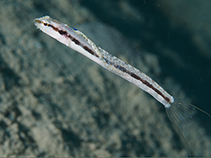| Family: |
Blenniidae (Combtooth blennies), subfamily: Blenniinae |
| Max. size: |
3.54 cm SL (female) |
| Environment: |
pelagic-neritic; marine; depth range 1 - 15 m |
| Distribution: |
Western Indian Ocean: Red Sea, Egypt. |
| Diagnosis: |
Dorsal spines (total): 9-9; Dorsal soft rays (total): 19-19; Anal spines: 2-2; Anal soft rays: 19-19; Vertebrae: 32-32. This species is distinguished by the following: D IX, 19; gill opening extending ventrally to opposite 5th or 6th dorsalmost pectoral-fin ray; 32 total vertebrae (Ref. 89959); cirri associated with most of (probably all) the dentary pores and several of the preopercular pores (Ref. 117352). |
| Biology: |
The species' slender body is well-suited for using as shelter abandoned calcareous polychaete tube, especially if protective cover is scarce. The type locality is mostly sand, broken shells and rubble with occasional seagrass beds (Ref. 89959). This species was also found to occupy empty shells of scaphopod mollusc Dentalium (Ref. 117352). |
| IUCN Red List Status: |
Data deficient (DD); Date assessed: 11 April 2012 Ref. (130435)
|
| Threat to humans: |
harmless |
Source and more info: www.fishbase.org. For personal, classroom, and other internal use only. Not for publication.
